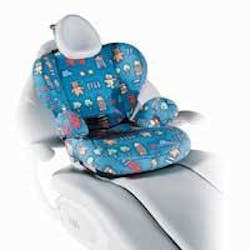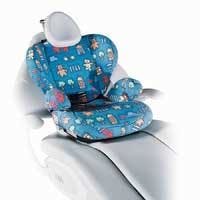Posture and positioning
by Anne Nugent Guignon, RDH, MPH
Another dental hygiene day has come and gone. The the net result is a few more bucks in the bank and a few more patients with a better chance of keeping their teeth for a lifetime. However, are you also leaving the office with a few more microtraumas or a few more aches and pains than yesterday? Unless you are taking the issue of good posture seriously, I can hear many of you mumbling under your breath about a sore neck, aching back, or hand pain.
A major reason why so many are exhausted at the end of the workday is directly to compromised body postures. For most clinicians, the level of fatigue mounts steadily as the work week progresses. Poor posture is a root cause of many repetitive stress injuries, which plague an amazing number of dental professionals.
Some clinicians are expected to use chairs without lumbar supports or, even worse, a chair designed for a dental assistant. Our bodies need chairs designed with a good lumbar support. The design of an assistant’s stool is specific for that type of work and is not a safe substitute for a dental hygienist.
Solutions to postural problems range from simple to complex. First, take a look at how you sit. Do you perch on the edge of your stool? If the answer is yes, then you’re begging for a backache. The chair’s lumbar support and seat pan are designed to give your thighs and entire upper torso a good postural foundation.
Strain to the lower back is dramatically reduced when you adjust the chair height so that your hip joint is a couple of inches higher than your knees. If the seat pan is too deep, use a chair with a smaller seat. Some clinicians even use a supplemental back support system or a pillow between their body and the back of the chair to shorten the seat. Clinicians with short legs can now purchase operator chairs that are designed to descend farther, making it possible to sit properly and to keep your feet flat on the floor. Unfortunately, not all patient chairs can be positioned low enough to accommodate shorter clinicians.
Clinician chairs fitted with arms, positioned to fit the individual user, are another way to obtain proper body posture and support. Chair arms may seem awkward at first, but once one gets through the learning curve, it is impossible to sit comfortably in a chair without upper limb support. Arm supports also help clinicians create a neutral body posture, so the entire musculoskeletal system is balanced.
Many clinicians also raise the patient chair too high because they are desperate to improve visual acuity. However, a patient chair that is too high forces you to position your arms away from the trunk of your body. It is quite common to see clinicians leaning forward with rounded shoulders and their neck bent in an awkward position, just to keep the oral cavity in focus.
A postural imbalance like this can cause problems all along the muscular path. Since muscles are attached to bone, a chronically imbalanced muscle will disrupt the balance of other muscles all the way down the line. Over time, the chest muscles shorten while the back muscles elongate, resulting in a perpetual stoop characterized by rounded shoulders, a sunken chest, and a head that juts forward.
Loupes do more than magnify what we see in the oral cavity, they are the key to proper posture. Properly fitted magnification loupes allow one to sit up straight with forearms close to the sides, and to position the patient’s head at waist level. Even though reading glasses provide an enlarged image, they are not a substitute for quality magnification because they are not designed to visualize objects that have depth such as the oral cavity.
The design of the patient chair can create problems, as well. Wide-bodied patient chairs are toxic because they cause most clinicians to lean forward in an awkward position with their arms extended out, just to reach the patient. Chairs with thick backs also contribute to postural problems. Some chairs can be retrofitted with a slimmer, smaller back, commonly known as a pediatric style, for a fraction of the cost of a new chair. There are other solutions to the chair dilemma. These can include switching treatment rooms or repositioning the patient chair in the workspace. Some chairs are easy to move around and others can be repositioned by releasing the locking mechanism at the base of the chair.
Patient positioning can be an important culprit as well. Even though patient comfort should be taken into account, patient time in the chair is usually only about 45 minutes to an hour. In the meantime, our bodies are subjected to hours of poor positioning that would make the famous contortionist, Houdini, sweat.
It’s really hard to treat a patient who positions their chin to their chest, or reaching with difficulty the oral cavity of a large-chested patient. Placing a small pillow or a comfortable roll of towels under their neck and shoulders will cause their chin to rise magically out of their chest. Special pillows and specialty neck supports are great for arthritic patients or those with osteoporosis. Positioning the patient’s head for proper visualization can also reduce elbow abduction or stretching the head forward in an unsupported position.
Small children can also be hard to treat. A number of clever booster chairs, body supports, or large pillows can elevate tiny patients so that their head is close to the top of the chair. One company even has a special child seat, covered with a bright fabric, which looks just like a kid’s car seat.
Another clinical challenge that frustrates most hygienists is the patient who refuses to let you recline the back of the patient chair. Certainly there are patients with legitimate reasons for not having the chair reclined, but the majority never says a word when the doctor lowers the back to a clinician-friendly position. While we certainly need to be sympathetic and accommodating to those patients who really need to be more upright, there are some strategies that can help prevent back strain in these situations.
Recline the patient chair back a few inches before you bring them into the room. Pre-positioning the chair back gives you a “new” point zero to start from. Or ask your doctor to come in at the beginning of the appointment, so the patient is positioned correctly from the start. An even sneakier move is to lower the back of the chair more than necessary, and then raise it slightly to compensate for the overcorrection.
Our reality is an aching body, and changing their perceptions may just work.
In some cases, standing may be your only choice. In this case, it’s wise to use a back support to help prevent injury. If nothing else works, massage the truth. Mention to your patient that you are worried about or have already developed back problems. If all else fails, tell your patient that you can’t provide a thorough appointment if you can’t see what you’re doing.
Correct positioning of your equipment is also very important. Everything that you use on a regular basis should be located within a short reach, and directly in front of you. Save the twisting, turning, stretching, and bending for your exercise class. Our treatment rooms are serious workstations, not model homes where everything is neatly stashed away. Poor equipment positioning is epidemic in most dental treatment rooms. Two of the most serious problems arise when a solo clinician, as is the case for many hygienists, is assigned to a room with a rear delivery system, a set-up designed for those who practice with an assistant. Another disturbing problem crops up when a left-handed clinician is expected to work in a treatment room that was designed for a right-handed person. Proper posture in dental hygiene is hard enough without having to face these kinds of problems.
Handpieces and hoses can contribute to postural problems as well. It is very difficult to maintain a neutral wrist posture if your handpiece is too heavy, long, or unbalanced. Contemporary handpieces are shorter and lighter in weight than those designed years ago. Heavy, curled hoses further exacerbate the situation, since the user must fight constant tension from the cord. A cordless, polishing handpiece solves both problems, and it is easy and inexpensive to retrofit equipment with lightweight, straight hoses.
Polishing angles are another source of potentially poor posture. While right angles are the norm in dental hygiene, it is nearly impossible to maintain a neutral wrist position with this type of design. In contrast, contra-angled polishers, which feature a small bend in the neck, allow one to maintain a straight wrist, even while accessing difficult areas.
Gloves are important as well. The all-purpose ambidextrous exam glove, designed for a procedure lasting a few seconds to a few minutes, poses significant postural problems for the user’s thumb. Ambidextrous gloves force all of your fingers into one plane, which is totally contrary to human anatomy, and places the thumb into a different place than the other four fingers. Clinicians experiencing any hand or thumb pain should seriously consider using hand-specific gloves designed to replicate the exact thumb position.
Analyzing, understanding and creating your personal comfort zone can be a challenge, but without question, the end result is practicing with perfect posture.
Anne Nugent Guignon, RDH, MPH, is an international speaker, has published numerous articles, and authored several textbook chapters. Her popular programs include ergonomics, patient comfort, burnout, and advanced diagnostics and therapeutics. Recipient of the 2004 Mentor of the Year Award, Anne is an ADHA member and has practiced clinical dental hygiene in Houston, Texas, since 1971. You can reach her at [email protected] or (713) 974-4540 and her Web site is www.ergosonics.com.

